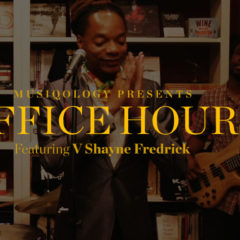Sometimes a song sticks in your head for days or weeks or months, reverberating around your skull and senses. This phenomenon—which goes by many names including “sticky music,” “Involuntary Musical Imagery,” and “earworm,” the most common usage—has been the subject of a number of rigorous scientific studies in recent years.
Many of these inquiries seek to understand earworms from a musicological sense, where song structure, lyrics, and chord progressions might play a role in setting hooks deep into our cognitions and checking the “repeat-one” button in our internal sonic streaming devices. Memories, places, words, sounds, smells, and various other experiences have been known to trigger them, keeping them locked into our personal mental playlists and making them stick with us in ways that fly contrary to our rapid-fire media consumption moment, where one song transitions seamlessly to the next one and we passively receive song after song at our desk or on our commute.
Generally, earworms are thought of as an annoyance or a frustration. You know that feeling…when you catch yourself humming a song for the umpteenth time and you groan in frustration. Is it the mark of successful songcraft, where sonic virality exists not in media or Twitter’s trending topics but instead in our own bodies? Is it a record label’s dream, a product so honed that we consume it over and over and over again?
Or is it something else?
My personal earworm, which has been bouncing around my head for more than two months at this point, is called “After Laughter (Comes Tears).”
Written and recorded by STAX artist Wendy Rene in 1964, “After Laughter” first came on my sonic radar due to its use in the trailer for Mid90s, a Jonah Hill-directed look at skater culture and teenage angst in Los Angeles releasing on October 19. It stopped me in my tracks when I heard it in the previews before Sorry to Bother You (a must-see, if you haven’t yet) and again during my viewing of Spike Lee’s BlacKkKlansman (still great but more fraught, as Sorry’s director Boots Riley thoughtfully explains).
Wendy Rene (née Mary Frierson) came of age in Memphis in the golden age of the city, when STAX Records’ marquee burned brightly and the soulful sounds of Booker T, Otis Redding, and the label’s cavalcade of black stars found its way onto the charts and the national consciousness. Many a music fan likely found the infectious “(Sittin on) The Dock of the Bay” or “In the Midnight Hour” stuck in their heads, even at a time when STAX artists might not be welcome on their side of town. Rene and her brother, Johnny, who performed with her and a pair of friends as The Drapels, co-wrote “After Laughter” and released it as her first single for the label.
Despite Booker T’s organ flourishes, iconic at the time, “After Laughter (Comes Tears)” was never a major hit for Rene, who recorded for STAX for a few years, releasing songs with the Drapels and one other single, “Bar-B-Q,” with Steve Cropper before fatefully choosing not to get on the plane that sent Otis Redding and others to their deaths in 1967 Either way, the Cleveland concert would have been her final show even if the plane hadn’t tragically not returned to Memphis: She was a young mother and had decided to leave the industry to raise her children.
It’s hard to see how “After Laughter” didn’t do better on the charts considering how hard it hits—the sixteen-year-old Rene’s tender lament, delivered with innocence and vulnerability, is undergirded by power and expertise as a vocalist and a feeler. This teenager articulates that feeling—that comes over your body as you try not to cry but your tear ducts have other ideas—that laughter and peace seldom last despite our best intentions. “You will see those wet little tears,” she declares knowingly. She’s right.
That was what it was like for me when I visited Memphis in 2017. Driving the seven minutes from STAX to the Lorraine Motel and pulling up into the parking lot on a day when grey clouds obscured every inch of the sky’s blue is a feeling I’ll never forget. A quiet pall hung over the grounds. It felt fitting and necessary, as if the weather’s like that there every day…as if the clouds understood their duty and had taken up permanent residence overhead.
The National Civil Rights Museum built up around the Lorraine is a triumph of preservation and an incredible tribute to the steadfast bravery and indomitable spirit of black Americans. That is necessary to state again and again to avoid unnecessary and melodramatic nihilism when discussing race in America, particularly for white writers. The story of our black friends and neighbors is a triumph of persistence, where the quotidian experience of the day-to-day is remarkable given the atmospheric forces that make it harder than it should be to draw breath, much less laugh.
But it can also be, as Wendy Rene reminds us, a tremendously sad story. In my reflections on Memphis, I mentioned the marble tablet that sits below the Lorraine’s balcony, bearing Dr. King’s accomplishments and a quote from Genesis—“They said to one another, behold here cometh the dreamer. Let us slay him and we shall see what will become of his dreams.” What I didn’t mention then was that, as I stood there alone at the tablet, my quiet, wet tears fell like rain from the sentinel clouds, running like rivulets through the etched letters of that tablet. It didn’t feel like crying for melodrama or to be seen or to show anyone else how devoted to the cause I was. It felt like crying because I was sad.
I also didn’t mention the deep disquiet I felt as I entered the museum doors behind a quartet of my fellow white, thirty-something tourists. They of course deserved to be there as much as I did, and my discomfort was not because of their appearance or their presence. It was because they were laughing.
Sadness sticks like earworms do, where despite our wants and deep desires, it will return. Wendy Rene’s sure of it, and she’s right. As I mourn a personal tragedy—the accidental death of my brother—her song sticks in my head, heart, and soul not solely because of its structure or its lyrics or its chord progression. It’s because I feel in communion with its interstitial message, sitting strangely comfortably between laughter and tears.
It’s comforting that I’m also not alone in considering this tune, either. Alicia Keys reworked Rene’s tune as “Where Do We Go From Here” on her 2007 album As I Am, trading the former’s certainty and acceptance into questions, another in-between moment at a crossroads in a failing relationship. Wu-Tang Clan sampled and reworked it as “Tearz,” the B-side to their first vinyl single release. Their version is particularly gutting entry into the genre of autodidactic rap, where a tour through life in struggle—a “message” or a “good day” or a “reminiscence” or a “story” or something else—details this teetering betweenness. Here, it’s RZA, asking why his own brother, a good one like the rest of them, had to die and Ghostface Killah lamenting (albeit pretty grossly misogynistically) a friend’s H.I.V diagnosis. Ghostface’s friend tellingly hadn’t yet been visited by Shaolin scythe-bearer to enact his then-death sentence. He, too, was in the in between.
This is all to say that sometimes a song sticks because you need it to stick as you navigate transitions. Sometimes we need to be reminded that laughter and tears can coexist, that that balance may feel tenuous but it’s actually a resting state for a city that’s been mourning for fifty years like Memphis or a person that’s been mourning for a few months like I have. A friend of Rene’s son is said to have heard “Tearz” on the radio and shared it with her; profits from Keys’s use were said to have been sufficient for Rene to purchase a home in Memphis. The publicity from Keys and Wu-Tang’s samples led to a late-in-life recognition and a reissue of her works by Light in the Attic Records in 2012. The album cover features Rene in the polka-dotted STAX studio, singing into a microphone with a faraway gaze in between the microphone and the camera’s lens. It is that in between she chronicled, balanced on the cusp of the after.
Wendy Rene took the stage one last time, in September 2010 at a festival in New Orleans, performing a short set made bittersweet by the surprise death of her brother, Johnny, a few months earlier. She would sadly pass herself in 2014, but she reverberates indefinitely in my head, helping me navigate befores and afters and laughters and tears.

 Share On Facebook
Share On Facebook Tweet It
Tweet It








